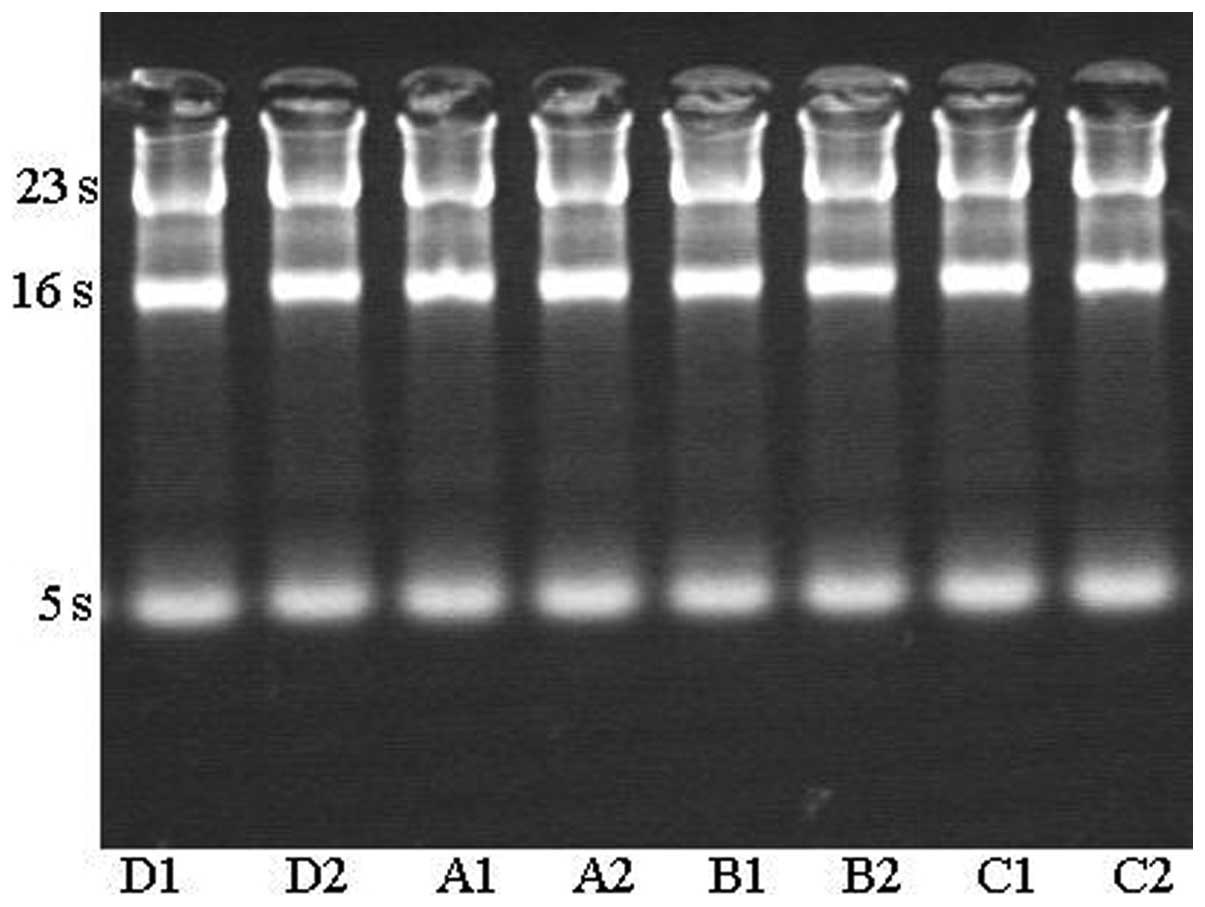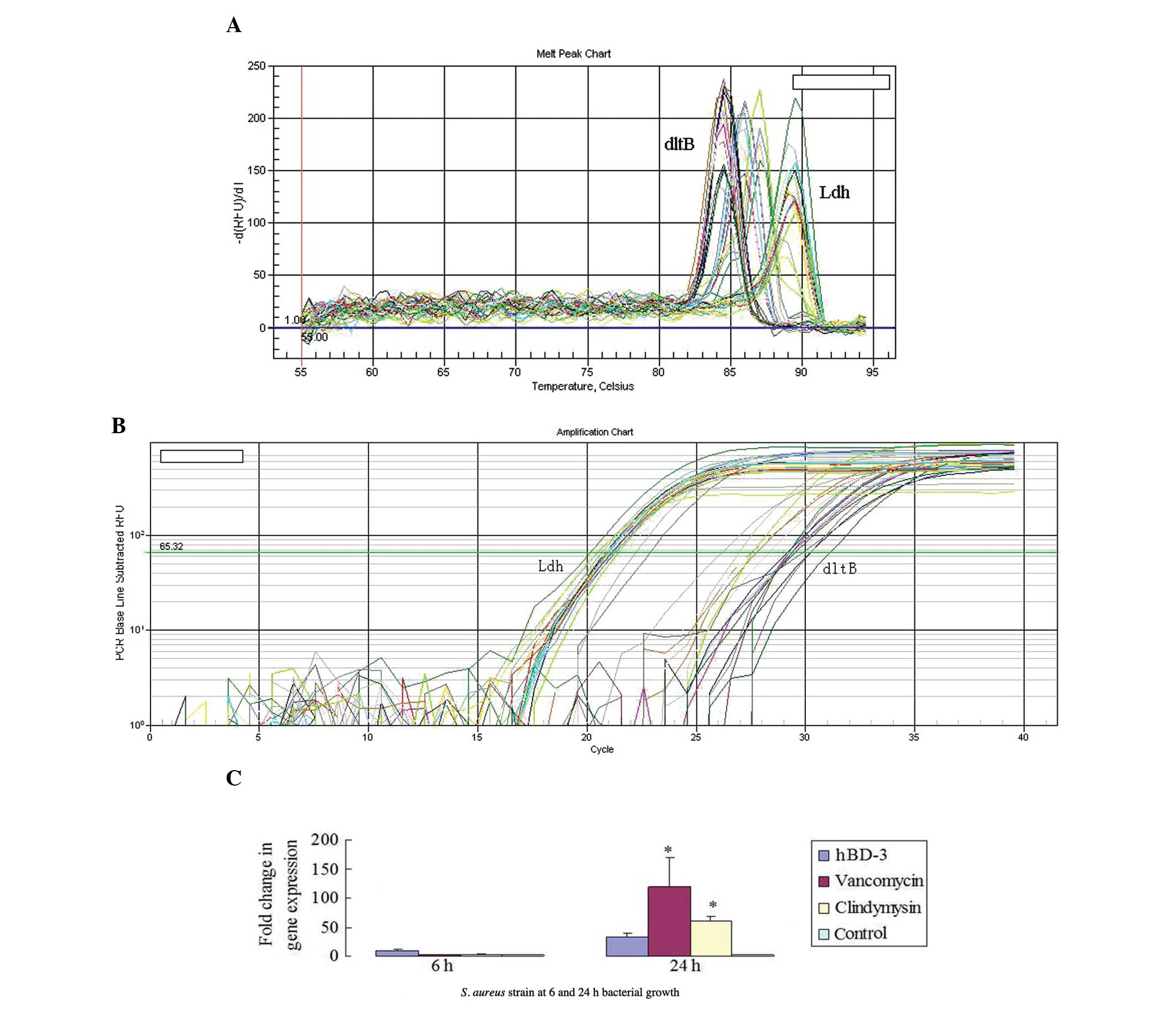|
1
|
Sohail MR, Uslan DZ, Khan AH, Friedman PA,
Hayes DL, Wilson WR, Steckelberg JM, Stoner SM and Baddour LM: Risk
factor analysis of permanent pacemaker infection. Clin Infect Dis.
45:166–173. 2007. View
Article : Google Scholar : PubMed/NCBI
|
|
2
|
Bjarnsholt T, Kirketerp-Møller K, Jensen
PØ, Madsen KG, Phipps R, Krogfelt K, Høiby N and Givskov M: Why
chronic wounds will not heal: a novel hypothesis. Wound Repair
Regen. 16:2–10. 2008. View Article : Google Scholar : PubMed/NCBI
|
|
3
|
Costerton JW, Stewart PS and Greenberg EP:
Bacterial biofilms: a common cause of persistent infections.
Science. 284:1318–1322. 1999. View Article : Google Scholar : PubMed/NCBI
|
|
4
|
Hoffman LR, D’Argenio DA, MacCoss MJ,
Zhang Z, Jones RA and Miller SI: Aminoglycoside antibiotics induce
bacterial biofilm formation. Nature. 436:1171–1175. 2005.
View Article : Google Scholar : PubMed/NCBI
|
|
5
|
Debabov DV, Heaton MP, Zhang Q, Stewart
KD, Lambalot RH and Neuhaus FC: The D-Alanyl carrier protein in
Lactobacillus casei: cloning, sequencing, and expression of
dltC. J Bacteriol. 178:3869–3876. 1996.PubMed/NCBI
|
|
6
|
Neuhaus FC, Heaton MP, Debabov DV and
Zhang Q: The dlt operon in the biosynthesis of
D-alanyl-lipoteichoic acid in Lactobacillus casei. Microb
Drug Resist. 2:77–84. 1996. View Article : Google Scholar : PubMed/NCBI
|
|
7
|
Neuhaus FC and Baddiley J: A continuum of
anionic charge: structures and functions of D-alanyl-teichoic acids
in gram-positive bacteria. Microbiol Mol Biol Rev. 67:686–723.
2003. View Article : Google Scholar : PubMed/NCBI
|
|
8
|
Gross M, Cramton SE, Götz F and Peschel A:
Key role of teichoic acid net charge in Staphylococcus
aureus colonization of artificial surfaces. Infect Immun.
69:3423–3426. 2001. View Article : Google Scholar : PubMed/NCBI
|
|
9
|
Caiazza NC and O’Toole GA: Alpha-toxin is
required for biofilm formation by Staphylococcus aureus. J
Bacteriol. 185:3214–3217. 2003. View Article : Google Scholar : PubMed/NCBI
|
|
10
|
Frees D, Chastanet A, Qazi S, Sørensen K,
Hill P, Msadek T and Ingmer H: Clp ATPases are required for stress
tolerance, intracellular replication and biofilm formation in
Staphylococcus aureus. Mol Microbiol. 54:1445–1462. 2004.
View Article : Google Scholar : PubMed/NCBI
|
|
11
|
Götz F: Staphylococcus and biofilms. Mol
Microbiol. 43:1367–1378. 2002.
|
|
12
|
Pratten J, Foster SJ, Chan PF, Wilson M
and Nair SP: Staphylococcus aureus accessory regulators:
expression within biofilms and effect on adhesion. Microbes Infect.
3:633–637. 2001. View Article : Google Scholar
|
|
13
|
Valle J, Toledo-Arana A, Berasain C, Ghigo
JM, Amorena B, Penadés JR and Lasa I: SarA and not sigmaB is
essential for biofilm development by Staphylococcus aureus.
Mol Microbiol. 48:1075–1087. 2003. View Article : Google Scholar : PubMed/NCBI
|
|
14
|
Vuong C, Saenz HL, Götz F and Otto M:
Impact of the agr quorum-sensing system on adherence to polystyrene
in Staphylococcus aureus. J Infect Dis. 182:1688–1693. 2000.
View Article : Google Scholar : PubMed/NCBI
|
|
15
|
Cramton SE, Gerke C, Schnell NF, Nichols
WW and Götz F: The intercellular adhesion (ica) locus is present in
Staphylococcus aureus and is required for biofilm formation.
Infect Immun. 67:5427–5433. 1999.PubMed/NCBI
|
|
16
|
Mack D, Nedelmann M, Krokotsch A,
Schwarzkopf A, Heesemann J and Laufs R: Characterization of
transposon mutants of biofilm-producing Staphylococcus
epidermidis impaired in the accumulative phase of biofilm
production: genetic identification of a hexosamine-containing
polysaccharide intercellular adhesin. Infect Immun. 62:3244–3253.
1994.PubMed/NCBI
|
|
17
|
Mack D, Fischer W, Krokotsch A, Leopold K,
Hartmann R, Egge H and Laufs R: The intercellular adhesin involved
in biofilm accumulation of Staphylococcus epidermidis is a
linear beta-1,6-linked glucosaminoglycan: purification and
structural analysis. J Bacteriol. 178:175–183. 1996.PubMed/NCBI
|
|
18
|
Mack D, Riedewald J, Rohde H, Magnus T,
Feucht HH, Elsner HA, Laufs R and Rupp ME: Essential functional
role of the polysaccharide intercellular adhesin of
Staphylococcus epidermidis in hemagglutination. Infect
Immun. 67:1004–1008. 1999.PubMed/NCBI
|
|
19
|
McKenney D, Hübner J, Muller E, Wang Y,
Goldmann DA and Pier GB: The ica locus of Staphylococcus
epidermidis encodes production of the capsular
polysaccharide/adhesin. Infect Immun. 66:4711–4720. 1998.
|
|
20
|
O’Gara JP: ica and beyond: biofilm
mechanisms and regulation in Staphylococcus epidermidis and
Staphylococcus aureus. FEMS Microbiol Lett. 270:179–188.
2007.PubMed/NCBI
|
|
21
|
Warnke PH, Springer IN, Russo PA, Wiltfang
J, Essig H, Kosmahl M, Sherry E and Acil Y: Innate immunity in
human bone. Bone. 38:400–408. 2006. View Article : Google Scholar : PubMed/NCBI
|
|
22
|
Harder J, Bartels J, Christophers E and
Schroder JM: Isolation and characterization of human
beta-defensin-3, a novel human inducible peptide antibiotic. J Biol
Chem. 276:5707–5713. 2001. View Article : Google Scholar : PubMed/NCBI
|
|
23
|
Joly S, Maze C, McCray PB Jr and
Guthmiller JM: Human beta-defensins 2 and 3 demonstrate
strain-selective activity against oral microorganisms. J Clin
Microbiol. 42:1024–1029. 2004. View Article : Google Scholar : PubMed/NCBI
|
|
24
|
Maisetta G, Batoni G, Esin S, Florio W,
Bottai D, Favilli F and Campa M: In vitro bactericidal activity of
human beta-defensin 3 against multidrug-resistant nosocomial
strains. Antimicrob Agents Chemother. 50:806–809. 2006. View Article : Google Scholar : PubMed/NCBI
|
|
25
|
Sahly H, Schubert S, Harder J, Rautenberg
P, Ullmann U, Schröder J and Podschun R: Burkholderia is highly
resistant to human beta-defensin 3. Antimicrob Agents Chemother.
47:1739–1741. 2003. View Article : Google Scholar : PubMed/NCBI
|
|
26
|
Maisetta G, Batoni G, Esin S, Luperini F,
Pardini M, Bottai D, Florio W, Giuca MR, Gabriele M and Campa M:
Activity of human beta-defensin 3 alone or combined with other
antimicrobial agents against oral bacteria. Antimicrob Agents
Chemother. 47:3349–3351. 2003. View Article : Google Scholar : PubMed/NCBI
|
|
27
|
Brogden KA: Antimicrobial peptides: pore
formers or metabolic inhibitors in bacteria? Nat Rev Microbiol.
3:238–250. 2005. View Article : Google Scholar : PubMed/NCBI
|
|
28
|
van der Plas MJ, Jukema GN, Wai SW,
Dogterom-Ballering HC, Lagendijk EL, van Gulpen C, van Dissel JT,
Bloemberg GV and Nibbering PH: Maggot excretions/secretions are
differentially effective against biofilms of Staphylococcus
aureus and Pseudomonas aeruginosa. J Antimicrob
Chemother. 61:117–122. 2008.PubMed/NCBI
|
|
29
|
Li M, Cha DJ, Lai Y, Villaruz AE,
Sturdevant DE and Otto M: The antimicrobial peptide-sensing system
aps of Staphylococcus aureus. Mol Microbiol. 66:1136–1147.
2007. View Article : Google Scholar : PubMed/NCBI
|
|
30
|
Neut D, Hendriks JG, van Horn JR, van der
Mei HC and Busscher HJ: Pseudomonas aeruginosa biofilm
formation and slime excretion on antibiotic-loaded bone cement.
Acta Orthop. 76:109–114. 2005. View Article : Google Scholar
|
|
31
|
Livak KJ and Schmittgen TD: Analysis of
relative gene expression data using real-time quantitative PCR and
the 2(−Delta Delta C(T)) method. Methods. 25:402–408. 2001.
|
|
32
|
Fu W, Forster T, Mayer O, Curtin JJ,
Lehman SM and Donlan RM: Bacteriophage cocktail for the prevention
of biofilm formation by Pseudomonas aeruginosa on catheters
in an in vitro model system. Antimicrob Agents Chemother.
54:397–404. 2010. View Article : Google Scholar : PubMed/NCBI
|
|
33
|
Peschel A, Otto M, Jack RW, Kalbacher H,
Jung G and Götz F: Inactivation of the dlt operon in
Staphylococcus aureus confers sensitivity to defensins,
protegrins, and other antimicrobial peptides. J Biol Chem.
274:8405–8410. 1999.PubMed/NCBI
|
|
34
|
Koprivnjak T, Mlakar V, Swanson L,
Fournier B, Peschel A and Weiss JP: Cation-induced transcriptional
regulation of the dlt operon of Staphylococcus aureus. J
Bacteriol. 188:3622–3630. 2006. View Article : Google Scholar : PubMed/NCBI
|
|
35
|
Li M, Lai Y, Villaruz AE, Cha DJ,
Sturdevant DE and Otto M: Gram-positive three-component
antimicrobial peptide-sensing system. Proc Natl Acad Sci USA.
104:9469–9474. 2007. View Article : Google Scholar : PubMed/NCBI
|
|
36
|
Bera A, Biswas R, Herbert S, Kulauzovic E,
Weidenmaier C, Peschel A and Götz F: Influence of wall teichoic
acid on lysozyme resistance in Staphylococcus aureus. J
Bacteriol. 189:280–283. 2007. View Article : Google Scholar : PubMed/NCBI
|
|
37
|
Kraus D and Peschel A: Staphylococcus
aureus evasion of innate antimicrobial defense. Future
Microbiol. 3:437–451. 2008. View Article : Google Scholar
|
|
38
|
Herbert S, Bera A, Nerz C, Kraus D,
Peschel A, Goerke C, Meehl M, Cheung A and Götz F: Molecular basis
of resistance to muramidase and cationic antimicrobial peptide
activity of lysozyme in staphylococci. PloS Pathog. 3:e1022007.
View Article : Google Scholar : PubMed/NCBI
|
|
39
|
Kuroda M, Kuwahara-Arai K and Hiramatsu K:
Identification of the up- and down-regulated genes in
vancomycin-resistant Staphylococcus aureus strains Mu3 and
Mu50 by cDNA differential hybridization method. Biochem Biophys Res
Commun. 269:485–490. 2000. View Article : Google Scholar : PubMed/NCBI
|
|
40
|
Cui L, Lian JQ, Neoh HM, Reyes E and
Hiramatsu K: DNA microarray-based identification of genes
associated with glycopeptide resistance in Staphylococcus
aureus. Antimicrob Agents Chemother. 49:3404–3413. 2005.
View Article : Google Scholar : PubMed/NCBI
|














